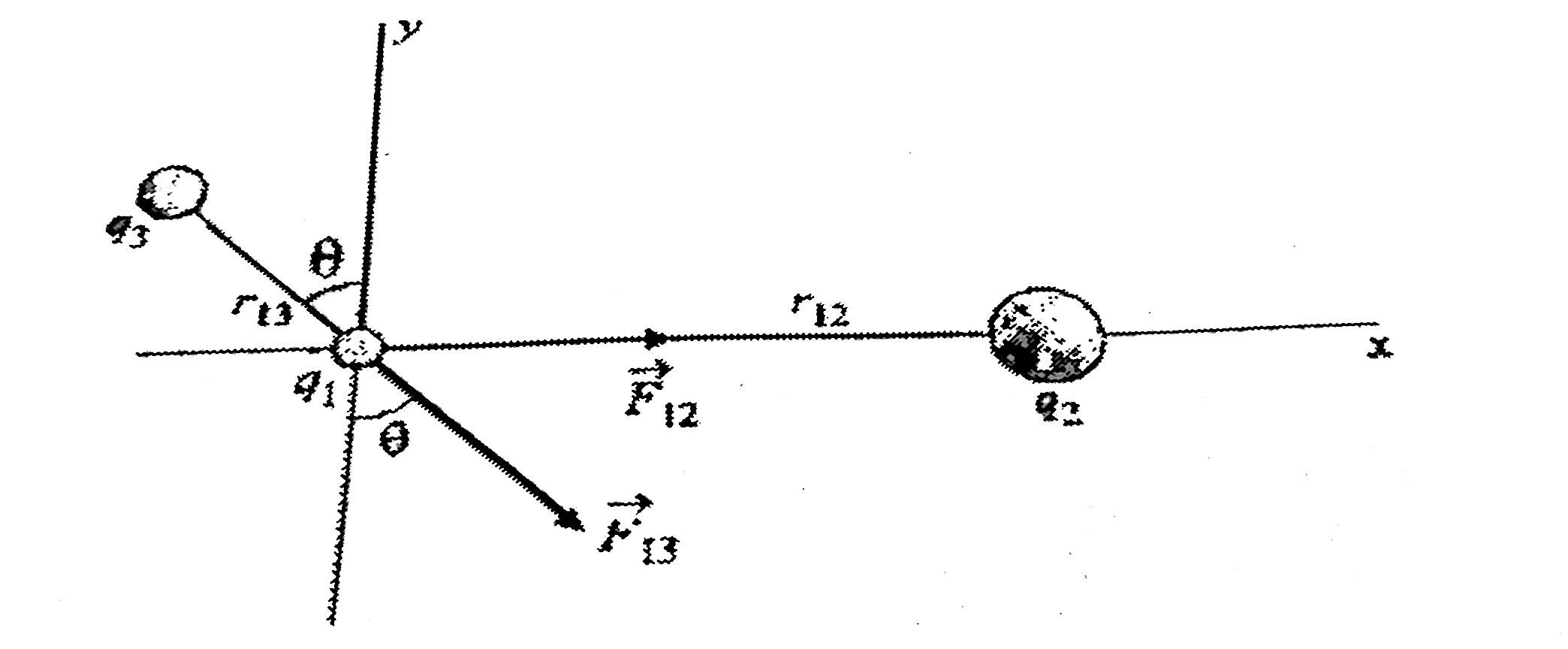Find the force on a charge q1(=20μC) due to the charge of q2(=10μC) if the positions of the charges are given as P1(1,−1,2) and Q(−1,1,1).
 .
.
−→F12=q1q2−→F124πε0r312
where →r12=→r1−→r2=(ˆi−ˆj+2ˆk)−(ˆi+ˆj=ˆk)
=2ˆi−2ˆj+ˆk
and r12=∣∣→F12∣∣√4+4+1=3
or, →F12=(9×109)(20×10−6)(−10×10−6)(3)3(2ˆi−2ˆj+ˆk)
=−0.06(2ˆi−2ˆj+ˆk)N.

Topper's Solved these Questions
- COULOMB LAW AND ELECTRIC FIELDBook:CENGAGE PHYSICSChapter:COULOMB LAW AND ELECTRIC FIELDExercise:Subjective
Explore 32 Videos
- COULOMB LAW AND ELECTRIC FIELDBook:CENGAGE PHYSICSChapter:COULOMB LAW AND ELECTRIC FIELDExercise:Single Correct
Explore 47 Videos
- COULOMB LAW AND ELECTRIC FIELDBook:CENGAGE PHYSICSChapter:COULOMB LAW AND ELECTRIC FIELDExercise:Solved examples
Explore 10 Videos
- COMMUNICATION SYSTEMBook:CENGAGE PHYSICSChapter:COMMUNICATION SYSTEMExercise:QUESTION BANK
Explore 19 Videos
- Current ElectricityBook:CENGAGE PHYSICSChapter:Current ElectricityExercise:QUESTION BANK
Explore 40 Videos
Similar Questions
The force of interaction between two charges q1=6μC and q2=2μCis 12N .If charge q=−2μC is added to each of the charges,then the new force of interaction is
View SolutionThree charges q1=1μC,q2=−2μC and q3=3μC are placed on the vertices of an equilateral triangle of side 1.0 m. find the net electric force acting on charge q1.
How to proceed Charge q2 will attract charge q1 (along the line joining them) and charge q3 will repel charge q1. Therefore, two forces will act on q1, one due to q2 and another due to q3. Since , the force is a vector quantity both of these force (say F1 and F2) will be added by vector method. Following are two methods of their addition

View Solution
Knowledge Check
The given figure gives electric line of force due to two charges q1 and q2. What are the signs of the two charges ?
 Aq1 is positive but q2 is negativeBq1 is negative but q2 is positiveCBoth are negativeDBoth are positive
Aq1 is positive but q2 is negativeBq1 is negative but q2 is positiveCBoth are negativeDBoth are positiveThe given figure gives electric line of force due to two charges q1 and q2. What are the signs of the two charges ?
 ABoth are negativeBBoth are positiveCq1 is positive but q2 is negativeDq1 is negative but q2 is positive
ABoth are negativeBBoth are positiveCq1 is positive but q2 is negativeDq1 is negative but q2 is positiveThe electric force on a charge q1 due to q2 is (4ˆi−3ˆj)N. What is the force on q2 due to q1?
A(4ˆi−3ˆj)NB(4ˆi+3ˆj)NC(−4ˆi−3ˆj)ND(−4ˆi+3ˆj)N
Three charges q1,q2 and q3 are shown in figure . Determine the net force acting on charge q1 . The charges and separation are given as q1=−1.0×10−6C,q2=+3.0×10−6C, and q3=−2.0×10−6C,r12=15cm,r13=10cm and θ=30∘.

View SolutionThree concentric metallic spherical shells of radii R, 2R, 3R are given charges Q1Q2Q3, respectively. It is found that the surface charge densities on the outer surface of the shells are equal. Then, the ratio of the charges given to the shells Q1:Q2:Q3 is
View SolutionThree concentric metallic spherical shells of radii R, 2R, 3R are given charges Q1Q2Q3, respectively. It is found that the surface charge densities on the outer surface of the shells are equal. Then, the ratio of the charges given to the shells Q1:Q2:Q3 is
View SolutionA charge q1 exerts some force on a second charge q2 If a third charge q3 is brought near q2, then the force exterted by q1 on q2
View SolutionIn fig two equal positive point charge q1=q2=2.0μC. Interact with a third point charge Q=4.0μC. The magnitude as well as direction of the net force on Q is

View Solution

